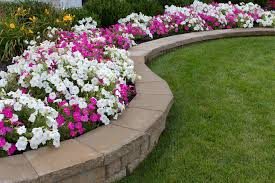How to Avoid Landscaping that Leads to Basement Perils
In spite of Old Man WInter’s final push this season, Spring really is just around the corner. After you dig out of that final snow, it won’t be long before the chill in the air will be nothing more than a memory, and you’ll be able to enjoy the outdoors again. In fact, like many homeowners, you already may be dreaming of working in your garden and all the beautiful flowers, shrubs, and trees you’ll be planting. Curb appeal is important, of course, but keep in mind that many of the plants you choose to beautify your home may also cause problems for your home’s basement and foundation if you’re not careful to choose the right ones. Here are three common problems and how to avoid them.
Trees
Trees can be wonderful additions to your yard. They give us shade in the Summer, places to build tree houses for the kids, and beautiful leaves in the Fall. However, these towering timbers can also be the lead culprit of cracked foundations and basement walls if they’re planted too close to your home. Here’s the problem: trees have complex root systems which provide them water, but can also grow nearly three times as wide in diameter as their canopy. In their pursuit of moisture, many roots head towards drainage systems near basements and foundations. As they grow, they displace the surrounding soil, adding pressure on basement walls. Once the pressure becomes too much you will find yourself with cracked walls and crumbling foundations, both of which compromise the integrity of your home.
Here are a few species of trees that are known for their aggressive root systems
-Poplars
-Cottonwoods
-Willows
-Aspens
-Silver Maples
Be sure to keep these types of trees a safe distance from your home and be sure to choose trees with less aggressive root systems if you’re looking for coverage around your home’s perimeter.
Plants
Flowering plants and shrubs are an easy way to beautify your yard. They can also lead to problems with your foundation. If planted too close to your home, shrubbery can take nearly all of the water out of the surrounding soil. This causes the soil to contract, leaving gaps next to your foundation. Even worse, those gaps quickly fill with water during heavy rain causing additional trouble. Some bushes and plants may even lead to clogging debris or pests in the window well of your egress window or pests, so it is important to choose plants for the perimeter of your home that maintain their leaves all year long.
We’re not talking about school, here. Your yard also has a grade. The grade is the incline of your yard moving away from your home. A yard’s grade provides a natural path for excess water to run away from the base of your home. This prevents flooding and other water damage to both your basement and your foundation. Grading requirements can vary depending on where you are located, but generally your yard should have a 2% grade to remove excess water. What does this mean? This means that there should be a 6 inch slope for the first 10 feet from your foundation and continue a 1 foot slope for every 50 feet of yard. Seem complicated? There are many professional landscapers who can help ensure that this project is done correctly.
So now what?
In spite of the fact that there are things to consider when choosing plants and trees for your yard, we are not suggesting that you turn your yard into a desert. Actually, tearing up trees and shrubs haphazardly can cause more damage, so you’ve got to be wise. Here are some tips for you to consider before planting this Spring:
-If planting trees, choose a species that isn’t know for it’s aggressive root system.
-Plant trees anywhere from 25 ft – 50 ft away from your home’s basement and foundation.
-Make sure your yard has a 2% grading to ensure proper drainage.
-Don’t plant bushes and shrubs any closer than 5 ft from your foundation.
-Choose plant varieties that need little water and that tend not to lose their leaves if you’re planting them close to your home’s foundation.
Creating a strategic landscaping plan will not only help the appearance of your house, but will also protect you from any unwanted basement and foundation issues in the future.




Leave a Reply
Want to join the discussion?Feel free to contribute!